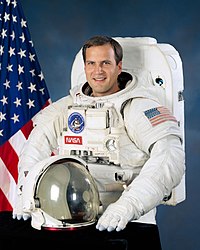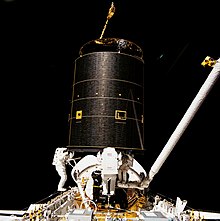Richard Hieb
| Richard Hieb | |
|---|---|
 | |
| Land: | USA |
| Organisation: | NASA |
| ausgewählt am | 4. Juni 1985 (11. NASA-Gruppe) |
| Einsätze: | 3 Raumflüge |
| Start des ersten Raumflugs: | 28. April 1991 |
| Landung des letzten Raumflugs: | 23. Juli 1994 |
| Zeit im Weltraum: | 31d 22h 34min |
| EVA-Einsätze: | 3 |
| EVA-Gesamtdauer: | 17h 38min |
| ausgeschieden am | 3. April 1995 |
| Raumflüge | |
Richard James Hieb (* 21. September 1955 in Jamestown, North Dakota) ist ein ehemaliger US-amerikanischer Astronaut.
Ausbildung
Hieb erhielt 1977 einen Bachelor in Mathematik und Physik vom Northwest Nazarene College und 1978 einen Master in Luft- und Raumfahrttechnik von der University of Colorado.
Astronautentätigkeit
1979 kam Hieb zur NASA und arbeitete dort zunächst in der Entwicklung und Planung von Aufgaben für die Raumfahrer. Er arbeitete im Kontrollzentrum im Team, das für den Start der ersten Space-Shuttle-Mission STS-1 zuständig war und unterstützte zahlreiche folgende Missionen. Nach einer vergeblichen Bewerbung für die zehnte Astronautengruppe wurde Hieb im Juni 1985 von der NASA als Mitglied der elften Gruppe ausgewählt.
STS-39
Am 28. April 1991 startete Hieb als Missionsspezialist mit der Raumfähre Discovery ins All. STS-39 war die erste nicht geheime Shuttle-Mission des US-Verteidigungsministeriums. Bei dieser Mission wurde lediglich das MPEC-Experiment als geheim eingestuft. Des Weiteren wurden die südlichen Polarlichter untersucht, verschiedene Experimente durchgeführt und mehrere kleine Satelliten ausgesetzt.
STS-49
Am 7. Mai 1992 flog Hieb als Missionsspezialist auf dem Jungfernflug der Raumfähre Endeavour zum zweiten Mal ins All. Ziel dieser Mission war es, den zwei Jahre zuvor gestarteten Kommunikationssatelliten Intelsat VI-F3 für eine Reparatur zu bergen. Erst mit dem dritten Außenbordeinsatz (EVA) konnte der Satellit schließlich von Hand eingefangen werden. Daraufhin erhielt Intelsat einen neuen Apogäumsmotor, damit er eine vorgesehene geostationäre Umlaufbahn erreichen konnte. Bei einer weiteren EVA wurden Strukturen und Werkzeuge getestet.
STS-65
Für die Mission STS-65 flog Hieb als Missionsspezialist mit der Raumfähre Columbia am 8. Juli 1994 zum dritten Mal in den Weltraum. Rund neunzig Experimente aus den Bereichen Biologie und Materialwissenschaften standen während des 15-tägigen Spacelab-Fluges auf dem Programm. Am 23. Juli landete die Columbia auf dem Kennedy Space Center in Florida.
Nach der NASA
1995 schied Hieb aus der NASA aus und war danach bei der Allied Signal Technical Services Corporation in Greenbelt beschäftigt. Zurzeit ist er Vizepräsident für zivile Programme bei Lockheed Martin Mission Services.
Richard Hieb ist verheiratet und hat zwei Kinder.
Siehe auch
Weblinks
- Kurzbiografie von Richard Hieb bei spacefacts.de
- Biografie von Richard Hieb in der Encyclopedia Astronautica (englisch)
- NASA-Biografie von Richard Hieb (englisch; PDF)
| Personendaten | |
|---|---|
| NAME | Hieb, Richard |
| ALTERNATIVNAMEN | Hieb, Richard James (vollständiger Name) |
| KURZBESCHREIBUNG | US-amerikanischer Astronaut |
| GEBURTSDATUM | 21. September 1955 |
| GEBURTSORT | Jamestown, North Dakota |
Auf dieser Seite verwendete Medien
STS-49 Patch
- STS-49 Endeavour, Orbiter Vehicle (OV) 105, crew insignia (logo), the official insignia of the NASA STS-49 mission, captures space flight's spirit of exploration which has its origins in the early seagoing vessels that explored the uncharted reaches of Earth and its oceans. The ship depicted on the patch is HMS Endeavour, the sailing vessel which Captain James Cook commanded on his first scientific expedition to the South Pacific. Just as Captain Cook engaged in unprecedented feats of exploration during his voyage, on Endeavour's maiden flight, its crew will expand the horizons of space operations with an unprecedented rendezvous and series of three space walks. During three consecutive days of extravehicular activity (EVA), the crew will conduct one space walk to retrieve, repair and deploy the INTELSAT IV-F3 communications satellite, and two additional EVAs to evaluate the potential Space Station Freedom (SSF) assembly concepts. The flags flying on Endeavour's masts wear the colors of the two schools that won the nationwide contest when Endeavour was chosen as the name of NASA's newest Space Shuttle: Senatobia (Mississippi) Middle School and Tallulah Falls (Georgia) School The names of the STS-49 flight crewmembers are located around the edge of the patch. They are Commander Daniel C. Brandenstein, Pilot Kevin P. Chilton, Mission Specialist (MS) Pierre J. Thuot, MS Kathryn C. Thornton, MS Richard J. Hieb, MS Thomas D. Akers, and MS Bruce E. Melnick. Each crewmember contributed to the design of the insignia.
Three crewmembers of mission STS-49 hold onto the 4.5 ton International Telecommunications Organization Satellite (INTELSAT) VI after a six-handed "capture" was made minutes earlier during the mission's third extravehicular activity (EVA).
From left to right: Mission Specialists(MS) Richard J. Hieb, Thomas D. Akers, and Pierre J. Thuot.
The three prepare to attach the capture bar which is tethered to Hieb. Thuot is positioned on the Remote Manipulator System (RMS) arm, from which he had made two earlier unsuccessful grapple attempts on two-person EVA sessions. Ground controllers and crewmembers agreed that a third attempt, using three mission specialists in the payload bay (PLB) was the effort needed to accomplish the capture feat. It worked, and to date, this remains the only three-person EVA.
Behind the three astronauts is the vertical perigee stage which will be attached to the Intelsat VI prior to its release from the PLB.STS-65 Mission Insignia
Portrait des Astronauten Richard Hieb
Emblem of Nasa's STS-39 mission.





